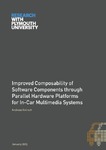Improved Composability of Software Components through Parallel Hardware Platforms for In-Car Multimedia Systems
| dc.contributor.supervisor | Wietzke, Joachim Prof. Dr.-Ing. | |
| dc.contributor.author | Knirsch, Andreas | |
| dc.contributor.other | Faculty of Science and Engineering | en_US |
| dc.date.accessioned | 2015-08-07T13:02:42Z | |
| dc.date.available | 2015-08-07T13:02:42Z | |
| dc.date.issued | 2015 | |
| dc.date.issued | 2015 | |
| dc.identifier | 10289423 | en_US |
| dc.identifier.uri | http://hdl.handle.net/10026.1/3511 | |
| dc.description | Full version unavailable due to 3rd party copyright restrictions. | |
| dc.description.abstract |
Recent years have witnessed a significant change to vehicular user interfaces (UI). This is the result of increased functionality, triggered by the continuous proliferation of vehicular software and computer systems. The UI represents the integration point that must fulfil particular requirements for usability despite the increased functionality. A concurrent present trend is the substitution of federated systems with integrated architectures. The steadily rising number of interacting functional components and the increasing integration density implies a growing complexity that has an effect on system development. This evolution raises demands for concepts that aid the composition of such complex and interactive embedded software systems, operated within safety critical environments. This thesis explores the requirements related to composability of software components, based on the example of In-Car Multimedia (ICM). This thesis proposes a novel software architecture that provides an integration path for next-generation ICM. The investigation begins with an examination of characteristics, existing frameworks and applied practice regarding the development and composition of ICM systems. To this end, constructive aspects are identified as potential means for improving composability of independently developed software components that differ in criticality, temporal and computational characteristics. This research examines the feasibility of partitioning software components by exploitation of parallel hardware architectures. Experimental evaluations demonstrate the applicability of encapsulated scheduling domains. These are achieved through the utilisation of multiple technologies that complement each other and provide different levels of containment, while featuring efficient communication to preserve adequate interoperability. In spite of allocating dedicated computational resources to software components, certain resources are still shared and require concurrent access. Particular attention has been paid to management of concurrent access to shared resources to consider the software components' individual criticality and derived priority. A software based resource arbiter is specified and evaluated to improve the system's determinism. Within the context of automotive interactive systems, the UI is of vital importance, as it must conceal inherent complexity to minimise driver distraction. Therefore, the architecture is enhanced with a UI compositing infrastructure to facilitate implementation of a homogenous and comprehensive look and feel despite the segregation of functionality. The core elements of the novel architecture are validated both individually and in combination through a proof-of-concept prototype. The proposed integral architecture supports the development and in particular the integration of mixed-critical and interactive systems. | en_US |
| dc.language.iso | en | en_US |
| dc.publisher | Plymouth University | en_US |
| dc.subject | Composability | en_US |
| dc.subject | In-Vehicle Infotainment | en_US |
| dc.subject | Automotive | en_US |
| dc.subject | In-Car Multimedia | en_US |
| dc.subject | Multicore | en_US |
| dc.subject | UI Compositing | en_US |
| dc.subject | Scheduling | en_US |
| dc.title | Improved Composability of Software Components through Parallel Hardware Platforms for In-Car Multimedia Systems | en_US |
| dc.type | Thesis | |
| plymouth.version | Edited version | en_US |
| dc.identifier.doi | http://dx.doi.org/10.24382/3513 |
Files in this item
This item appears in the following Collection(s)
-
01 Research Theses Main Collection
Research Theses Main


